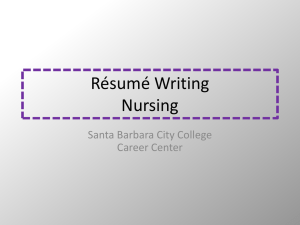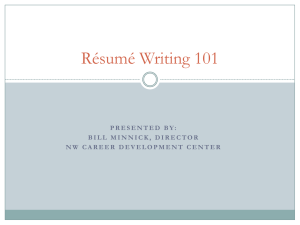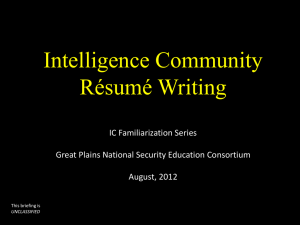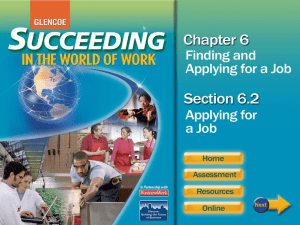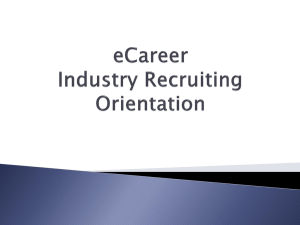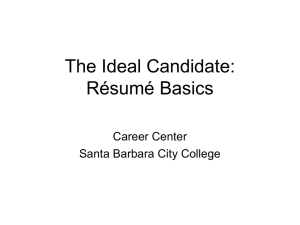RESUME PACKAGE - Business Information Management
advertisement
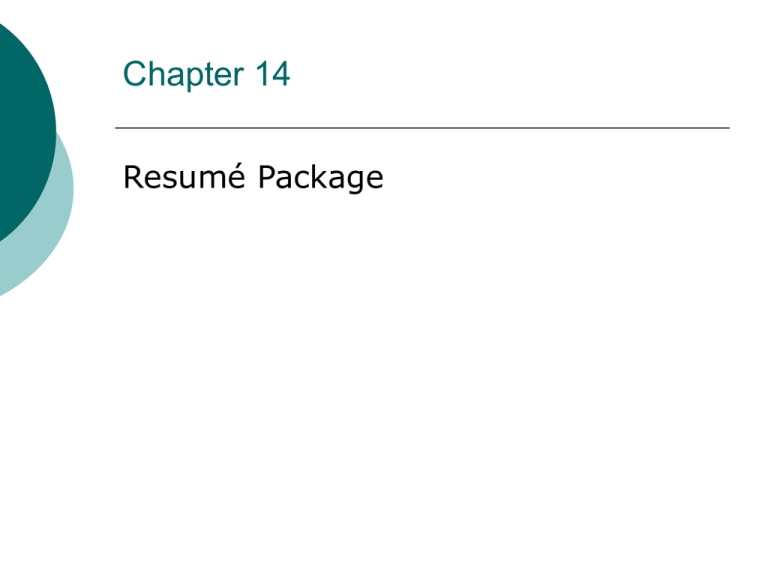
Chapter 14 Resumé Package “Whenever you are asked if you can do a job, tell ‘em, “Certainly I can!” Then get busy and find out how to do it.” Theodore Roosevelt (1858-1919) OBJECTIVES Identify the steps for building a résumé package Write a career objective or personal profile Distinguish between a functional résumé and a chronological résumé Identify personal soft-skills, job-specific skills and transferable skills Create a winning résumé Write a cover letter BUILDING YOUR RÉSUMÉ PACKAGE Résumé package-cover letter and résumé Résumé : a formal written profile that presents a person’s knowledge, skills, and abilities to potential employers Conflicting advice as to how the perfect résumé should look and what it should include Appropriate résumé depends on work experience A well written résumé makes it easy for potential employers to quickly identify your skills and work experience BUILDING YOUR RÉSUMÉ PACKAGE Five Steps toward a winning résumé: 1. Career Objective/Personal Profile 2. Gathering Information 3. Proper Layout 4. Skills, Accomplishments, and Experience 5. The Final Résumé As you construct your résumé, make every word, visual presentation, and information sell your skills and accomplishments STEP ONE: CAREER OBJECTIVE/PERSONAL PROFILE Both statements are used on résumé to relate to target career, target employer, introduce key skills, and express interest in a position Career Objective: used for individuals with little or no work experience Personal Profile: used for individuals with more extensive career experience STEP TWO: GATHERING INFORMATION Create draft document with the following key headings: Education Skills Employment Languages Honors and Awards Professional/Community Involvement Do not include personal information STEP THREE: PROPER LAYOUT Arrange information in proper résumé layout Functional résumé layout: Emphasizes relevant skills and education Used for entry-level positions Typically one page Chronological résumé layout: Emphasizes related work experience and skill sets Stresses major accomplishments and responsibilities Used for those with extensive career experience Typically two or more pages Figure 14-1 Figure 14-2 Figure 14-3 Figure 14-4 Figure 14-5 Figure 14-6 STEP THREE: PROPER LAYOUT Both résumé layouts present employment history and education in reverse time order When listing work history, bold job title, not employer When listing employment dates, use only month and year Be consistent in layout, dates, and tense Avoid the use of résumé templates TALK IT OUT Which résumé layout is best for your situation? Why? STEP FOUR: SKILLS, ACCOMPLISHMENTS & EXPERIENCE Provide details in electronic document Limited or no experience (functional layout) Learned skills, job duties, and accomplishments Work and/or career experience (chronological layout) Specific activities achieved beyond job duties Quantify skills, responsibilities, and accomplishments STEP FOUR: SKILLS, ACCOMPLISHMENTS & EXPERIENCE Job-specific skills: skills that are directly related to a specific job or industry May not be useful in a career change Example: A Medical Billing Clerk who knows how to use a specific software program such as Medical Manager would not need to use this skill if he or she changed jobs to become a teacher STEP FOUR: SKILLS, ACCOMPLISHMENTS & EXPERIENCE Transferable skills: skills that are transferred from one job to the next If you change careers, you will still be able to use (transfer) these skills Example: A Medical Billing Clerk may have consistent contact with patients and must practice patience and be positive when dealing with customers; if he or she becomes a teacher, that skill will be transferable to the children in the classroom STEP FOUR: SKILLS, ACCOMPLISHMENTS & EXPERIENCE Soft skills: people skills necessary when working with others in the workplace Employers want employees that are: Reliable Team players Good communicators Able to get along well with others STEP FOUR: SKILLS, ACCOMPLISHMENTS & EXPERIENCE When listing work experience Include job title (bold) Company name City and state of company Duties of the position When listing job duties Be as specific as possible First list skills most relevant to target job STEP FOUR: SKILLS, ACCOMPLISHMENTS & EXPERIENCE Identify key knowledge, skills, and abilities the employer desires Secure a copy of the job description Use O’Net, a database of occupational information developed by U.S. Department of Labor Excellent resource to ID key requirements for specific jobs http://online.onetcenter.org/ STEP FOUR: SKILLS, ACCOMPLISHMENTS & EXPERIENCE Power Words: action verbs that describe accomplishments in a lively and specific way STEP FOUR: SKILLS, ACCOMPLISHMENTS & EXPERIENCE Power words for skills section Ideal oral and written communications skills Understanding of office practices and procedures; ability to operate fax machine, copy machine, and ten-key machine; ability to enter data; ability to effectively interpret policies and procedures; work well under the pressure of deadlines; establish and maintain a positive working relationship with others; ability to communicate Accurate typing skills at ______ wpm Experienced with Microsoft Office, including Word, Excel, Access, PowerPoint, and Outlook STEP FOUR: SKILLS, ACCOMPLISHMENTS & EXPERIENCE Power words for skills section cont. Excellent English grammar, spelling, and punctuation skills Accurately proofread and edit documents Strong attention to detail Accurately follow oral and written instructions Excellent attendance and punctual record Maintain confidentiality Positive attitude, motivated, and organized STEP FOUR: SKILLS, ACCOMPLISHMENTS & EXPERIENCE Power words for work section Prepared reports and other materials requiring independent achievement Enjoy working in a flexible team situation Established and maintained positive and effective working relationships Planned, scheduled, and performed a variety of clerical work Maintained office equipment and supplies Proofread forms and materials for completeness and accuracy, according to regulations and procedures STEP FOUR: SKILLS, ACCOMPLISHMENTS & EXPERIENCE Power words for work section cont. Processed and prepared materials for pamphlets, bulletins, brochures, announcements, handbooks, forms, and curriculum materials Provided training of temporary or new employees Maintained department files and records Demonstrated ability to receive incoming calls and route them efficiently Experience power phrases Processed purchase requisitions, ordered and distributed supplies, and maintained inventory control Responsibly planned and conducted meetings STEP FIVE: COMPLETE THE RÉSUMÉ Information Heading: personal contact information including: Name (complete and formal – including middle initial) Mailing address (check for accuracy) City, state & zip code (check format, capitalization and punctuation) Contact phone (only one phone number) E-mail address (remove hyperlink, professional address) STEP FIVE: COMPLETE THE RÉSUMÉ Review Career Objective or Personal profile Ensure it introduces reader to who you are Encourage reader to learn about your specific knowledge, skills, abilities, and key accomplishments Review appropriate and proper résumé layout Confirm sub headings Consistent setup, tense Check spelling and grammar STEP FIVE: COMPLETE THE RÉSUMÉ Completion tips List experience and education chronologically (most recent first) Keep setup consistent (all periods or none, line spacing, alignment, format, uppercase/lowercase words) Be consistent with word endings (keep the tense the same in each section) STEP FIVE: COMPLETE THE RÉSUMÉ Underline, bold & italicize for emphasis only Only use bullets to emphasize key skills Use easy to read font and size Only use black ink Do not include personal information Times New Roman or Arial 12-14 point No photos, birth date, marital status, SSN or hobbies Do not list “References Available” on résumé STEP FIVE: COMPLETE THE RÉSUMÉ Professional presentation Printed on black ink (laser print ideal) 8½ x 11 inch, letter-sized paper Cotton fiber, 24 pound white paper (not bound) Single sided - if more than one page, place name at top of each page Do not staple documents STEP FIVE: COMPLETE THE RÉSUMÉ Check for information that is frequently forgotten or not presented appropriately STEP FIVE: COMPLETE THE RÉSUMÉ When you think it’s perfect … Have several individuals review for Clarity Consistency Punctuation Grammar Typographical errors Other potential mistakes SHARING YOUR RÉSUMÉ Start with a perfect résumé Online version Consider content-use keywords Send as an attachment to preserve formatting MS Word Portable document file (pdf) Electronic job boards Guard personal information SHARING YOUR RÉSUMÉ Electronic file Microsoft Word vs. portable document file (.pdf) Electronic formatted résumé: American Standard Code for Information Interchange (ASCII) Used when employers add résumé to special software to search applicants based on key words Special format Key words Times New Roman (10-14 point) Figure 14-7 COVER LETTERS Cover letter: formal letter used as an introduction to a résumé First impression for potential employers Use a friendly but professional tone Point out how you can meet the employer’s needs Do not duplicate resumé; instead, expand the areas of interest to target employer COVER LETTERS Although it is acceptable to utilize “I” and “my” in a cover letter, be careful not to begin most sentences with the word “I” Address cover letter to specific person Refer reader to the resumé Request interview (not job) at close of letter Display initiative COVER LETTERS Carefully review job announcement Identify key job skills, and highlight company needs Include key qualifications in both cover letter and résumé In the cover letter: Mention the target company by name Mention how you learned of the job List specific qualifications (reflected from the job posting) that make you an excellent candidate to interview Include daytime telephone number on both Telephone voice mail and/or message machine is professional Do not include introductions that are unprofessional COVER LETTERS Be honest with potential employer List jobs held while incarcerated (correctional facility in place of employer) List all education received while incarcerated (include educational institution that provided training) Do not lie on employment application Check “yes” Write “will explain during interview” Figure 14-8 Figure 14-9 Figure 14-10 TAILORING YOUR RESUMÉ AND COVER LETTER Identify key skills for your targeted position List key skills first on the resumé Emphasize specific qualification in the cover letter List phone and e-mail address on resumé and cover letter Make phone message professional Figure 14-11
